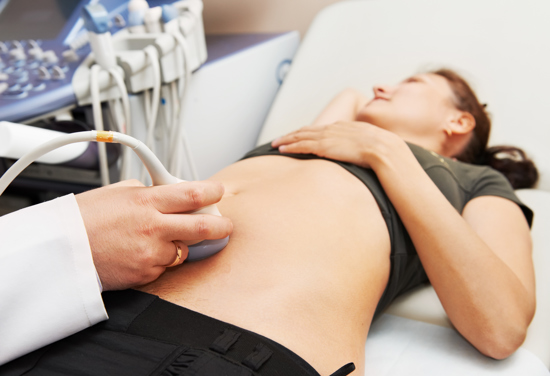In Norway, all pregnant women are offered two routine ultrasound scans through the public health service. An early ultrasound scan is offered between gestational weeks 11+0 and 13+6, while a routine ultrasound scan is offered between gestational weeks 17 and 19.
Both ultrasound examinations are voluntary and are just two of the pregnancy check-ups that are available to you.
What is ultrasound?
Ultrasound is high-frequency sound waves that cannot be heard by humans.
During the examination, a sound probe is passed over the pregnant woman's abdomen. The sound probe transmits sound waves into the uterus. The sound waves are reflected by the foetus, the umbilical cord and the placenta, and are picked up again by the sound probe. In this way, ultrasound can show detailed images of the foetus and various measurements can be taken.
In some cases, a transvaginal ultrasound scan performed through the vagina is used to obtain a better general picture of structures located deep in the pelvis.
No injuries have been recorded in infants as a result of an ultrasound examination as a foetus.
What happens during ultrasound examinations
Ultrasound scans are performed by midwives or doctors and take about half an hour.
You can bring your partner or someone else with you if you wish. We do not recommend bringing children to an ultrasound examination.
The sex of the foetus is not normally of any medical significance and is therefore not routinely disclosed.
Routine ultrasound scan during weeks 11+0 to 13+6 (early ultrasound scan)
An early ultrasound scan is voluntary and carried out in the first trimester, during gestational weeks 11+0 to 13+6. The purpose of the early ultrasound scan is to check that the pregnancy and foetal development are proceeding normally, to check the number of foetuses and to calculate the gestational age. An early ultrasound scan forms part of the standard prenatal diagnostics, and you will need to give your consent before you have the scan.
You will be given a preliminary due date at the time of the early ultrasound scan. The final due date will be determined during the routine ultrasound during gestational weeks 17 to 19.
In connection with the early ultrasound scan, you will be given information and offered a NIPT test for trisomy 13, 18 and 21 if you are entitled to this. You can read more about early ultrasound scans, NIPT and other prenatal diagnostics here.
Routine ultrasound scan during weeks 17 to 19
A routine ultrasound scan is performed during the second trimester, gestational weeks 17 to 19. This ultrasound scan involves an examination of the foetus and uterus to obtain information about:
- the foetal age and due date
- the number of foetuses
- the position of the placenta
- foetal development and anatomy
Age of the fetus and due date
The age of the fetus can be estimated from the date of the mother’s last menstruation. Using ultrasound enables the age of the fetus to be calculated more accurately based on measurements of the size of the fetus. This is important for assessing the fetus's growth and development, as well as for managing various conditions such as premature birth or overdue pregnancy.
A «full term» birth means that the baby is born during the period from 21 days before to 14 days after the due date. Approximately 90 percent of all women give birth during this period, and 6 percent of women give birth on the actual due date.
Number of fetuses
The ultrasound examination shows whether there are one or more fetuses. Multiple pregnancies (pregnancies with more than one fetus) are monitored with additional ultrasound examinations to check on the growth and development of the fetus.
Location of the placenta
The ultrasound examination indicates where the placenta is located in the uterus. Placenta that remains around the birth canal or covers the birth canal completely (placenta previa) will prevent a vaginal birth.
If the placenta is observed close to the birth canal around week 18, you will have a further ultrasound examination later in your pregnancy.
In most cases, the distance from the placenta to the birth canal will increase as the uterus grows, making vaginal delivery possible.
Fetal development and anatomy
The ultrasound examination involves a review of fetal development and anatomy. Most fetuses develop normally. In some cases, the ultrasound examination can help to identify developmental abnormalities in the fetus. You will then be offered further investigations and monitoring by specialists in fetal diagnostics.
The midwife or doctor who performs the examination is obliged to inform you of any possible developmental abnormalities.

Prenatal diagnostics in Norway
Prenatal diagnostics is offered to pregnant women who are at greater risk of having a fetus with a severe hereditary disease or developmental abnormality.
Illustration: Colourbox